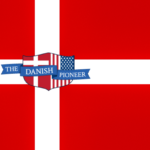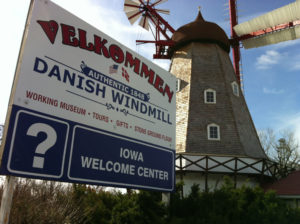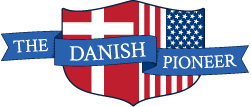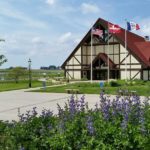
ON DANISH TV: Elk Horn flooded with calls and messages as Iowa’s Danish Villages spotlighted on television documentary in Denmark
Pride in heritage and fading identity highlighted in historic immigrant community —
ELK HORN, IOWA–Earlier this year, two Danish filmmakers descended upon the tiny towns of Elk Horn and Kimballton in rural western Iowa. The locals of the largest rural settlement of Danes welcomed them cautiously but openly, not knowing if the pair’s intentions were genuine or to poke fun at the little “Denmark on the prairie.”
After making several trips to Elk Horn, culminating with Memorial Day’s annual Tivoli Fest, the pair returned to Denmark but remained in contact with the locals. On Wednesday, August 28, 2013, Anders Birch and Jakob Vølver’s documentary Danmark på prærien aired on Denmark’s DR1 station at 8 p.m. local time. Immediately following the presentation (around 2 p.m. Central time) Elk Horn’s local businesses and attractions were flooded with calls, social media messages and e-mails from across the world.
The film and Elk Horn have been received warmly by its Danish viewers. Several Danes say they are planning trips to Elk Horn for next year’s Tivoli Fest. Comments like:
— “In Denmark, most of us become really proud when we see our country represented in the world because it is so small and we’re used to being unknown. Even though the people of Elk Horn may feel that the Danish culture is disappearing, most of us Danes appreciate that we’re known or even recognized.“
— “As an immigrant myself it was good to watch how they carry on Danish traditions. We first generation immigrants are so busy trying to become Americans that we let go of our past.”
— “Seeing how much Denmark seems to mean to your community makes a Danish person better understand what love of country is. Usually for us Danes being Danish is something we take for granted. Members of my family also left Denmark in the beginning of last century for the USA. Unfortunately we lost the connection to their descendants about a generation ago.”
— “From visiting Elk Horn on several occasions I really enjoyed the program. It was truly genuine, unfiltered and deeply affecting.”

The Danish Windmill in Elk Horn, Iowa greets visitors to the Danish Villages. (Photo by Linda Steffensen)
Though comments have been overwhelmingly positive, others were critical of the film including a Danish Immigrant Museum volunteer living in Denmark: “It was exciting and I enjoyed revisiting Elk Horn and the many places I know: The Danish Inn, the windmill, the cemetery, Bedstemors House, Main Street, etc. and it was fun to hear that still a few are speaking Danish. The program left me behind though with a feeling that it missed a lot about the community and especially about the museum. It gave a picture of a small town mostly talking about frikadeller, æbleskiver and medisterpølse, and to my thinking it did not give a fair impression of this charming, special, hardworking community.”
The film prominently featured the decidedly un-Danish custom of eating æbleskiver (pancake balls) with medisterpølse (sausages) for–gasp–breakfast! Æbleskiver are usually reserved for a Christmastime dessert after lunch or dinner, and not regularly eaten as a breakfast option nor with the spicymedisterpølse, as observed in many Danish American communities in the U.S. Danes are having quite a laugh at the American’s bastardized tradition and are readily offering up more suitable recipes from the homeland.
Elk Horn Mayor Stan Jens and resident Jordan Hansen were major storylines in the film and were in Copenhagen for the premiere. Now local–and “international”–celebrities, the duo is enjoying sudden popularity and conversations with Twitter followers around the world. Charismatic Major Jens has been well-received by the Danish public, even with his pro-gun stance, a hot-button issue on the Danish political scene. One Dane encouraged, “Vote the Mayor of Elk Horn for the next president, he is great!”
From the Danish and American flags on the light poles to red and white flag motifs painted on benches and Mini Coopers, Elk Horn wears its heritage on its sleeve and has done so for several decades since early Danish pioneers settled in the area. Billing itself as the Danish Villages in combination with the town of Kimballton, just a few miles north (and home to a replica of Copenhagen’s Little Mermaid statue), the rural area is an attraction for family history buffs, tourists and sightseers traveling on I-80.
Elk Horn greets you with its authentic Danish windmill and a vikinghjem. Other attractions include Bedstemor’s House, a 1908 immigrant home and museum on the National Register of Historic Places, The Danish Immigrant Museum four blocks west of the windmill, the Little Mermaid statue, a genealogy library, popular smörgåsbord restaurant The Danish Inn and more. But how long the community can hold true to its Danish roots is a question left up in the air.
“I myself come from a small place like Elk Horn, and I know what it feels like to ‘dream bigger,’ but I also know how important it is to bring some value into the small societies for the people who are living there,” one Danish woman wrote.
With only a few Danish immigrants and first-generation immigrants left in town, the community has seen dwindling numbers for involvement in traditions like Danish folk dancing, and fewer and fewer residents can speak and understand Danish. Local high school students and young professionals in the film expressed the desire to flee the area and its perceived lack of interesting things to do. Steve Rold, a 29-year-old Danish immigrant and former Exira-Elk Horn-Kimballton basketball coach was filmed leaving his hometown for a new opportunity in North Carolina.
John Mark Nielsen, Executive Director of The Danish Immigrant Museum in Elk Horn, commented on the bittersweet nature of the film, “Although it is exciting to be receiving the public attention that we are, the film brought to light some key issues for struggling rural towns across the country. As we focus on preserving the past, we must also look to the future and cultivate a sustainable model for our communities and shared heritage.”
The hour-long documentary, mostly in English, can be viewed online at http://www.dr.dk/tv/se/danmark-pa-praerien/danmark-pa-praerien/
========================================================================================
ABOUT THE DANISH PIONEER NEWSPAPER – SINCE 1872 – ENGLISH & DANISH ARTICLES
DID YOU KNOW THAT THE DANISH PIONEER NEWSPAPER WAS FOUNDED IN OMAHA, NEBRASKA IN 1872 AND TODAY IS STILL PUBLISHED JUST OUTSIDE CHICAGO, ILLINOIS? Did you know by supporting The Danish Pioneer Newspaper’s print edition, we are able to offer the bonus of our colorful, exciting website. Please support The Danish Pioneer Newspaper. Subscriptions to our print edition are economical, and you receive 26 issues per year including the extra-large, extra-special holiday issue. Subscriptions and advertisements – like annual donations to ethnic institutions or memberships to clubs and organizations – help The Danish Pioneer Newspaper staff to preserve and to support the Danish-American ethnic press in addition to allowing us to promote the Danish and Scandinavian culture, communities, heritage and traditions in the USA and North America. Please subscribe today or give The Danish Pioneer Newspaper as a gift subscription to a friend or relative. Visit http://www.thedanishpioneer.com/subscribe/
MANGE TAK! Thank you for your support and WELCOME to The Danish Pioneer Family!









